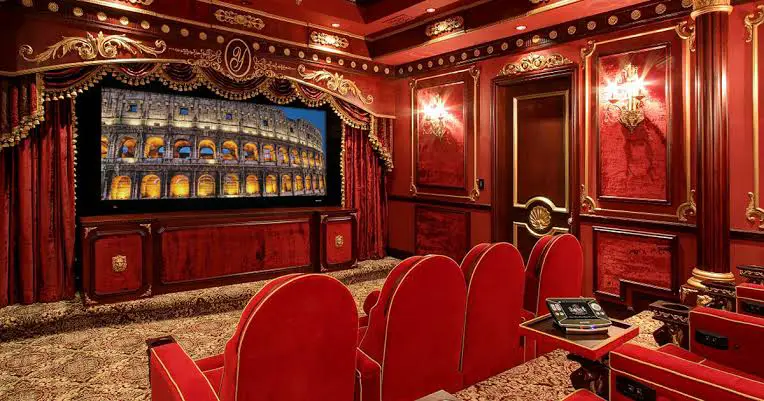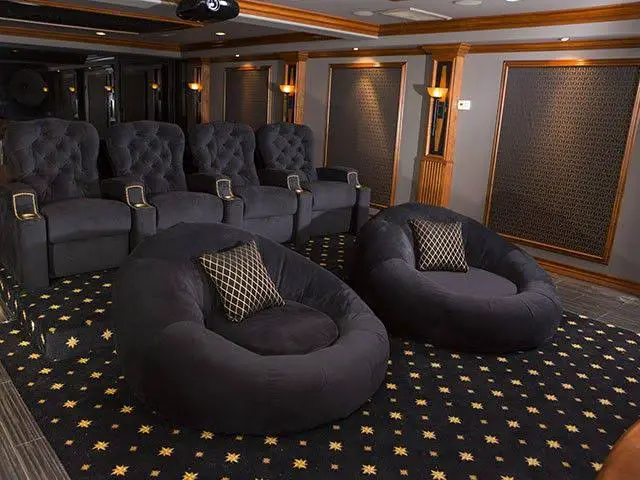
While there is nothing wrong with sticking to the traditional rooms of a standard house, there are plenty of other options to give your home that extra oomph. One of the best additions is a home theater. There’s nothing like kicking back after work and watching a show or two on your couch, and this wonderful feeling would be magnified a hundred-fold in a room that makes you feel you are at the cinemas.

Whether you plan on converting the living room, or you dedicate a special room for it, you’ll see that designing your own home theater is not that hard with these tips. Bring on the popcorn!
Layout
Before starting the design process, you’ll want to put some thought into the general room layout. Planning the layout ahead of time will save you serious missteps in the future. A rule of thumb for the layout of a theater room is this: Aim to optimize your viewing experience, not to maximize the seating space. This rule can be counterintuitive for a lot of people, because their first instinct is usually to take up every bit of available space in the room to accommodate as many persons as possible (It is, after all, a theater.). However, doing so will compromise the quality of your viewing experience. When seats are prioritized, things like the optimal distance and angle from the screen, or proper distance from speakers are forgotten.
Instead, the best route is to first choose the best place for the “king’s chair,” or the main viewer. Usually, it’s closer to the middle of the room. Next, figure out the screen size, taking into account where you’re seated. It has to be at a size and angle that is most comfortable from where you are sitting so that you won’t have to tilt your head so much or swivel around. After that, you can select a projector that’s going to match the location of the screen and seats. Choose the right distance from the projector to the screen that’s going to show the clearest images. Finally, you can figure out where to put your speakers. The optimal location to make the viewing experience more immersive is to put a set of speakers along each row, and not just at the back of the room, as is commonly done.

Soundproofing
Part of the charm of a theater comes from its padded walls that soundproof the room. Soundproofing is all the more important when the theater is at your home, as you wouldn’t want the occupants of other rooms or even the neighbors to be disturbed when you’re screaming at an onrushing tide of zombies. If your budget permits, you can install insulators on the walls, ceiling, and flooring. A cheaper option would be to use thick sound curtains. Prioritize insulating all the gaps in the room, especially the gap under the door.

Walls
For a look more akin to a cinema, you can dress up the walls. This can be as simple as painting the walls a dramatic color, or as elaborate as adding wooden panels with crown molding for a more luxurious aesthetic. Wooden panels look great covering the entirety of the wall, but a cheaper alternative that looks just as great is placing the panels only on the bottom part of the wall, with a plain wall on the upper portion.

Flooring
The classic flooring choice for any theater is still carpet flooring. Aside from the flamboyance and drama it adds to the space, carpet flooring also helps soundproof the room. However, you can opt for other materials, such as hardwood flooring. An easier option would be to place a small section rug near the seating area for decoration and texture.

Seating
The sky’s the limit for seating options, especially since this is your home theater and you will mostly have to account for your own comfort alone. The traditional route is to go for individual theater seating that provides ultimate relaxation for any guest. For that warm family feeling, use a big section sofa with several small sofas around the room. For an even friendlier atmosphere, a few pillows here and there or beanbags on the floor work wonders. You can even use a sofa bed for comfort plus versatility.

Additional Fun
Aside from the basics, additional décor and functional items can truly make your home theater one of a kind. Put up several poster frames of your favorite movies to evoke that cinema vibe. You can also place movie items on a rack or hang them on wall shelving. To impress your guests, place a trolley by the seating area as a refreshment center. If you want to go all out, you can even get a mini popcorn maker and place it by the corner of the room.
More Budget-Friendly Options
Home theaters are not exclusive to the wealthy. Anyone can have a home theater, because at the end of the day, only you can truly define what a theater means to you. If that means simply having a big rug in the middle of the room with throw pillows around, then so be it. Instead of spending a lot on soundproofing, you can select a room that creates less noise, such as your basement. Be creative and choose reasonably priced items, and you’ll be well on your way to enjoying a home theater that’s tailor-made for you.





